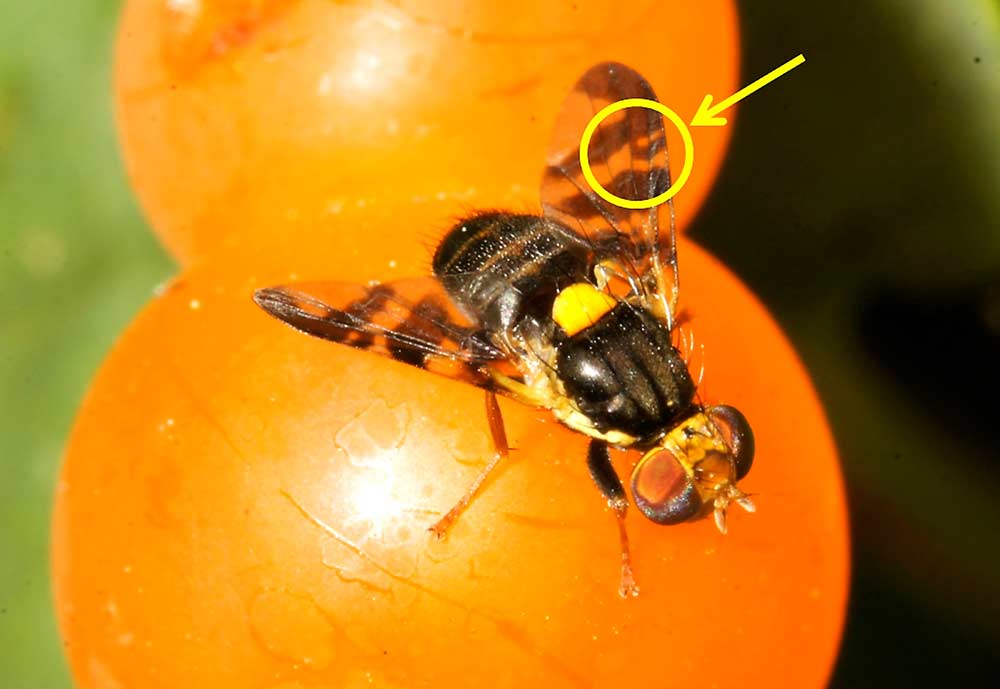U.S. officials are taking action to stop the potential spread of an invasive fruit fly that could threaten the cherry crop in New York state. The USDA’s Animal and Plant Health Inspection Service has established a quarantine area in a portion of Niagara County for European cherry fruit fly, already considered the most serious pest of sweet cherries in Europe.
The quarantine covers about 92 square miles in an area where the European cherry fruit fly was found in traps last September and October. Officials fear U.S. cherry growers could be hit by reduced access to foreign markets and lower prices if the pest becomes established in the U.S. Additional trapping surveys are underway to determine if the invasive fruit fly is present in other areas.

The pattern on the wing of the European Cherry Fruit Fly, Rhagoletis cerasi, can be used to distinguish it from native fruit flies. (Courtesy Steve Paiero, University of Guelph)
Here is the press release from USDA:
USDA Establishes European Cherry Fruit Fly Quarantine in Niagara County, New York
WASHINGTON, June 14, 2018 – The United States Department of Agriculture’s Animal and Plant Health Inspection Service (APHIS) has established a quarantine for European cherry fruit fly (ECFF) in New York. A portion of Niagara County is quarantined for the invasive fruit fly following the detection of 51 flies in 2017. APHIS and the New York State Department of Agriculture and Markets (NYSDAM) are working collaboratively on this detection.
European cherry fruit fly is the most serious pest of sweet cherries in Europe. The fly attacks only the fruit of its host plants, causing it to rot and fall off the tree. If European cherry fruit fly becomes established in the United States, it could affect U.S. access to foreign cherry markets and cause lower prices and economic losses for U.S. cherry growers.
The ECFF quarantine area encompasses approximately 92 square miles of Niagara County, and the quarantine boundary description can be found online at:
https://www.aphis.usda.gov/plant_health/plant_pest_info/fruit_flies/downloads/ecff-niagara-erie-ny-description.pdfThe quarantine affects local residents – residents are urged to consume homegrown cherries on site and not move the fruit from their property. Residents are also asked not to move soil underneath the drip line of an ECFF host plant in the regulated area, because doing so could spread fruit fly larva to other areas. A list of host plants can be found at: https://www.aphis.usda.gov/aphis/resources/pests-diseases/hungry-pests/ecff.
During September and October 2017, APHIS confirmed ECFF in traps placed in wild honeysuckle and sweet cherry on state and public lands along the Niagara River in Niagara County, New York. APHIS is responding to these detections by conducting another trapping survey this year. Throughout May and continuing this month, APHIS is placing about 6,000 traps in Niagara County and in a portion of Erie County. The trapping survey will help monitor the ECFF population and determine if there are other locations where the invasive fruit fly is present.
For more information on the pest, please see the pest alert at: https://www.aphis.usda.gov/publications/plant_health/2017/alert-ecff.pdf and the factsheet about trapping surveys at: https://www.aphis.usda.gov/publications/plant_health/fs-qa-ecff.pdf. Residents who think their cherry fruit is infested with fruit fly larvae are encouraged to call the toll-free ECFF Hotline at 1-800-249-2363.






Leave A Comment